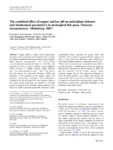Use este identificador para citar ou linkar para este item:
http://www.alice.cnptia.embrapa.br/alice/handle/doc/867159Registro completo de metadados
| Campo DC | Valor | Idioma |
|---|---|---|
| dc.contributor.author | SAMPAIO, F. G. | pt_BR |
| dc.contributor.author | BOIJINK, C. de L. | pt_BR |
| dc.contributor.author | SANTOS, L. R. B. DOS | pt_BR |
| dc.contributor.author | YOSHIOKA, E. T. O. | pt_BR |
| dc.contributor.author | KALININ, A. L. | pt_BR |
| dc.contributor.author | RANTIN, F. T. | pt_BR |
| dc.date.accessioned | 2011-04-09T18:03:41Z | - |
| dc.date.available | 2011-04-09T18:03:41Z | - |
| dc.date.created | 2010-11-17 | pt_BR |
| dc.date.issued | 2010 | pt_BR |
| dc.identifier.citation | Ecotoxicology, v. 19, n. 5, p. 963-976, 2010. | pt_BR |
| dc.identifier.uri | http://www.alice.cnptia.embrapa.br/alice/handle/doc/867159 | pt_BR |
| dc.description | Copper sulfate is widely used in aquaculture. Exposure to this compound can be harmful to fish, resulting in oxidative metabolism alterations and gill tissue damage. Pacu, Piaractus mesopotamicus, (wt = 43.4 ± 3.35 g) were distributed in experimental tanks (n = 10; 180 l) and exposed for 48 h to control (without copper addition), 0.4Cu (0.4 mg l?1), 0CupH (without copper addition, pH = 5.0) and 0.4CupH (0.4 mg l?1, pH = 5.0). In liver and red muscle, the superoxide dismutase (SOD) was responsive to the increases in the aquatic copper. The plasmatic intermediary metabolites and hematological variables in the fish of group 0.4Cu were similar to those of the control group. Conversely, the exposure to 0.4CupH caused an increase in the plasmatic lactate, number of red blood cells (RBC) and hemoglobin (Hb). Plasmatic copper concentration [Cup] increased in group 0.4Cu and 0.4CupH, which is higher in group 0.4CupH, suggests an effect of water pH on the absorbed copper. Exposure to 0.4Cu and 0.4CupH resulted in a reduction in the Na+/K+-ATPase activity and an increase in metallothionein (MT) in the gills. Exposure to 0CupH caused a decrease in glucose and pyruvate concentrations and an increase in RBC, Hb, and the branchial Na+/K+-ATPase activity. These responses suggest that the fish triggered mechanisms to revert the blood acidosis, save energy and increase the oxygen uptake. MT was an effective biomarker, responding to copper in different pHs and dissolved oxygen. Combined-factors caused more significant disturbance in the biomarkers than single-factors. | pt_BR |
| dc.language.iso | eng | eng |
| dc.rights | openAccess | eng |
| dc.title | The combined effect of cooper and low pH on antioxidant defenses and biochemical parameters in neotropical fish pacu, Piaractus mesopotamicus (Holmberg, 1887). | pt_BR |
| dc.type | Artigo de periódico | pt_BR |
| dc.date.updated | 2011-04-10T11:11:11Z | pt_BR |
| dc.subject.thesagro | Pacu | pt_BR |
| dc.subject.thesagro | Peixe | pt_BR |
| dc.subject.thesagro | Poluição | pt_BR |
| dc.subject.thesagro | Qualidade da Água | pt_BR |
| riaa.ainfo.id | 867159 | pt_BR |
| riaa.ainfo.lastupdate | 2011-03-29 | pt_BR |
| dc.identifier.doi | 10.1007/s10646-010-0478-z | pt_BR |
| dc.contributor.institution | FERNANDA GARCIA SAMPAIO, UFSCAR; CHEILA DE LIMA BOIJINK, CPAA; LAILA ROMAGUEIRA BICHARA DOS SANTOS; ELIANE TIE OBA YOSHIOKA, CPAF-AP; ANA LUCIA KALININ; FRANCISCO TADEU RANTIN. | pt_BR |
| Aparece nas coleções: | Artigo em periódico indexado (CPAA)  | |
Arquivos associados a este item:
| Arquivo | Descrição | Tamanho | Formato | |
|---|---|---|---|---|
| Ecotoxicology2010.pdf | 378,44 kB | Adobe PDF |  Visualizar/Abrir |









